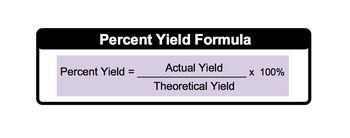Stoichiometry is a crucial concept in chemistry that allows us to predict the amount of product that can be generated from a given quantity of reactants. However, the true measure of success in a chemical reaction is determined by the percent yield, which reflects the efficiency of the reaction. A higher percent yield indicates a more successful synthesis of the desired product, similar to aiming for high scores on an exam.
Percent yield can be categorized into different levels of success: an excellent yield is 90% or greater, a very good yield ranges from 80% to 89%, a good yield is between 70% and 79%, and a poor yield is anything below 40%. Understanding these classifications helps in evaluating the effectiveness of a chemical process.
The formula for calculating percent yield is given by:
\[\text{Percent Yield} = \left(\frac{\text{Actual Yield}}{\text{Theoretical Yield}}\right) \times 100\]
This formula is essential to memorize, as it is often not provided on formula sheets. In this context, the actual yield refers to the amount of pure product obtained from the experiment, while the theoretical yield is the calculated amount based on stoichiometric principles.
It is important to note that the units of actual yield and theoretical yield must match when using the formula. For instance, if the actual yield is measured in grams, the theoretical yield must also be converted to grams from moles if necessary. This ensures accurate calculations.
No chemical reaction can achieve a 100% yield due to various factors such as loss of material during handling, incomplete reactions, or side reactions. Consequently, the actual yield is always less than the theoretical yield. By analyzing percent yield, actual yield, and theoretical yield, chemists can gain valuable insights into the efficiency and effectiveness of their chemical reactions.


